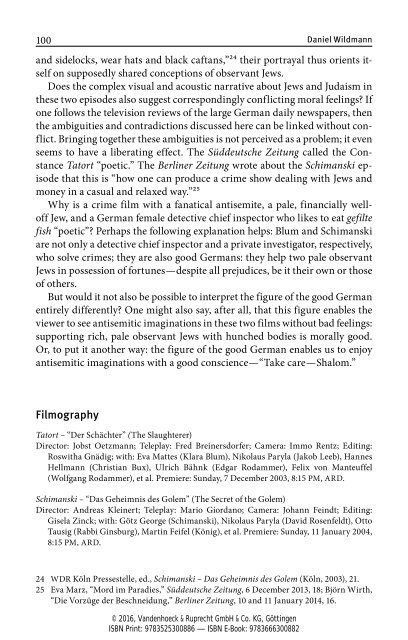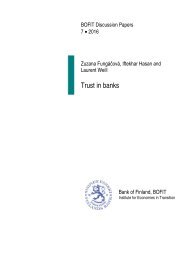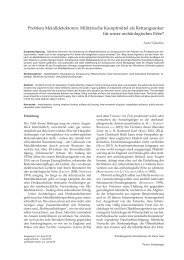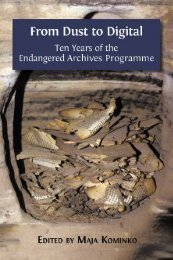Media and Minorities
9783666300882_ruhrmann_media_ebook_034247
9783666300882_ruhrmann_media_ebook_034247
Create successful ePaper yourself
Turn your PDF publications into a flip-book with our unique Google optimized e-Paper software.
100<br />
Daniel Wildmann<br />
<strong>and</strong> sidelocks, wear hats <strong>and</strong> black caftans,”24 their portrayal thus orients itself<br />
on supposedly shared conceptions of observant Jews.<br />
Does the complex visual <strong>and</strong> acoustic narrative about Jews <strong>and</strong> Judaism in<br />
these two episodes also suggest correspondingly conflicting moral feelings? If<br />
one follows the television reviews of the large German daily newspapers, then<br />
the ambiguities <strong>and</strong> contradictions discussed here can be linked without conflict.<br />
Bringing together these ambiguities is not perceived as a problem; it even<br />
seems to have a liberating effect. The Süddeutsche Zeitung called the Constance<br />
Tatort “poetic.” The Berliner Zeitung wrote about the Schi manski episode<br />
that this is “how one can produce a crime show dealing with Jews <strong>and</strong><br />
money in a casual <strong>and</strong> relaxed way.”25<br />
Why is a crime film with a fanatical antisemite, a pale, financially welloff<br />
Jew, <strong>and</strong> a German female detective chief inspector who likes to eat gefilte<br />
fish “poetic”? Perhaps the following explanation helps: Blum <strong>and</strong> Schi manski<br />
are not only a detective chief inspector <strong>and</strong> a private investigator, respectively,<br />
who solve crimes; they are also good Germans: they help two pale observant<br />
Jews in possession of fortunes — despite all prejudices, be it their own or those<br />
of others.<br />
But would it not also be possible to interpret the figure of the good German<br />
entirely differently? One might also say, after all, that this figure enables the<br />
viewer to see antisemitic imaginations in these two films without bad feelings:<br />
supporting rich, pale observant Jews with hunched bodies is morally good.<br />
Or, to put it another way: the figure of the good German enables us to enjoy<br />
antisemitic imaginations with a good conscience — “Take care — Shalom.”<br />
Filmography<br />
Tatort – “Der Schächter” (The Slaughterer)<br />
Director: Jobst Oetzmann; Teleplay: Fred Breinersdorfer; Camera: Immo Rentz; Editing:<br />
Roswitha Gnädig; with: Eva Mattes (Klara Blum), Nikolaus Paryla (Jakob Leeb), Hannes<br />
Hellmann (Christian Bux), Ulrich Bähnk (Edgar Rodammer), Felix von Manteuffel<br />
(Wolfgang Rodammer), et al. Premiere: Sunday, 7 December 2003, 8:15 PM, ARD.<br />
Schimanski – “Das Geheimnis des Golem” (The Secret of the Golem)<br />
Director: Andreas Kleinert; Teleplay: Mario Giordano; Camera: Johann Feindt; Editing:<br />
Gisela Zinck; with: Götz George (Schimanski), Nikolaus Paryla (David Rosenfeldt), Otto<br />
Tausig (Rabbi Ginsburg), Martin Feifel (König), et al. Premiere: Sunday, 11 January 2004,<br />
8:15 PM, ARD.<br />
24 WDR Köln Pressestelle, ed., Schimanski – Das Geheimnis des Golem (Köln, 2003), 21.<br />
25 Eva Marz, “Mord im Paradies,” Süddeutsche Zeitung, 6 December 2013, 18; Björn Wirth,<br />
“Die Vorzüge der Beschneidung,” Berliner Zeitung, 10 <strong>and</strong> 11 January 2014, 16.<br />
© 2016, V<strong>and</strong>enhoeck & Ruprecht GmbH & Co. KG, Göttingen<br />
ISBN Print: 9783525300886 — ISBN E-Book: 9783666300882







